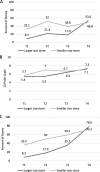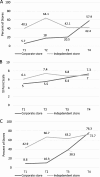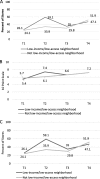Store and neighborhood differences in retailer compliance with a local staple foods ordinance
- PMID: 32019508
- PMCID: PMC7001202
- DOI: 10.1186/s12889-020-8174-2
Store and neighborhood differences in retailer compliance with a local staple foods ordinance
Abstract
Background: Policies to improve healthy food retail have been recognized as a potential means of reducing diet-related health disparities. The revised 2014 Minneapolis Staple Foods Ordinance instituted minimum stocking standards for healthy, staple foods. The objective of this study was to examine retailer compliance with the policy, and whether compliance varied by neighborhood and store characteristics.
Methods: In this natural experiment, audits were conducted annually pre- and post-ordinance (2014-2017) in 155 small/nontraditional stores in Minneapolis, MN and a comparison city (St. Paul, MN). Compliance measures for 10 product categories included: (1) met requirements for ≥8 categories; (2) 10-point scale (one point for each requirement met); and (3) carried any item in each category. Store characteristics included store size and ownership status. Neighborhood characteristics included census-tract socioeconomic status and low-income/low-access status. Analyses were conducted in 2018.
Results: All compliance measures increased in both Minneapolis and St. Paul from pre- to post-policy; Minneapolis increases were greater only for carrying any item in each category (p < 0.01). In Minneapolis, corporate (vs. independent) stores were generally more compliant. No differences were found by neighborhood characteristics.
Conclusions: Overall trends suggest broad movement among Minneapolis stores towards providing a minimum level of staple foods. Increases were greater in corporate stores. Trends do not suggest neighborhood-level disparities in compliance.
Study registration: ClinicalTrials.gov NCT02774330, retrospectively registered May 17, 2016.
Keywords: Food access; Neighborhood disparities; Policy; Small food store; Stocking standards.
Conflict of interest statement
The authors declare that they have no competing interests.
Figures




Similar articles
-
Evaluation of the first U.S. staple foods ordinance: impact on nutritional quality of food store offerings, customer purchases and home food environments.Int J Behav Nutr Phys Act. 2019 Sep 18;16(1):83. doi: 10.1186/s12966-019-0818-1. Int J Behav Nutr Phys Act. 2019. PMID: 31533737 Free PMC article. Clinical Trial.
-
Small food store retailers' views on healthy food retail policy in response to a local staple foods ordinance.Public Health Nutr. 2021 May;24(7):1934-1940. doi: 10.1017/S1368980020000580. Epub 2020 Jun 10. Public Health Nutr. 2021. PMID: 32517846 Free PMC article.
-
Longitudinal Fruit and Vegetable Sales in Small Food Retailers: Response to a Novel Local Food Policy and Variation by Neighborhood Socioeconomic Status.Int J Environ Res Public Health. 2020 Jul 29;17(15):5480. doi: 10.3390/ijerph17155480. Int J Environ Res Public Health. 2020. PMID: 32751326 Free PMC article.
-
Lack of Healthy Food in Small-Size to Mid-Size Retailers Participating in the Supplemental Nutrition Assistance Program, Minneapolis-St. Paul, Minnesota, 2014.Prev Chronic Dis. 2015 Aug 27;12:E135. doi: 10.5888/pcd12.150171. Prev Chronic Dis. 2015. PMID: 26312380 Free PMC article.
-
Changes to SNAP-authorized retailer stocking requirements and the supply of foods and beverages in low-income communities in seven U.S. states.Transl Behav Med. 2019 Oct 1;9(5):857-864. doi: 10.1093/tbm/ibz093. Transl Behav Med. 2019. PMID: 31570924
Cited by
-
A four-year observational study to examine the dietary impact of the North Carolina Healthy Food Small Retailer Program, 2017-2020.Int J Behav Nutr Phys Act. 2021 Mar 24;18(1):44. doi: 10.1186/s12966-021-01109-8. Int J Behav Nutr Phys Act. 2021. PMID: 33761952 Free PMC article.
-
Urban vs. Rural Socioeconomic Differences in the Nutritional Quality of Household Packaged Food Purchases by Store Type.Int J Environ Res Public Health. 2020 Oct 20;17(20):7637. doi: 10.3390/ijerph17207637. Int J Environ Res Public Health. 2020. PMID: 33092077 Free PMC article.
-
Secular trends and customer characteristics of sweetened beverage and water purchasing at US convenience and other small food stores, 2014-2017.Int J Behav Nutr Phys Act. 2022 Mar 31;19(1):37. doi: 10.1186/s12966-022-01268-2. Int J Behav Nutr Phys Act. 2022. PMID: 35361242 Free PMC article.
-
A Model Depicting the Retail Food Environment and Customer Interactions: Components, Outcomes, and Future Directions.Int J Environ Res Public Health. 2020 Oct 19;17(20):7591. doi: 10.3390/ijerph17207591. Int J Environ Res Public Health. 2020. PMID: 33086537 Free PMC article.
-
Elevated Dietary Inflammation Among Supplemental Nutrition Assistance Program Recipients Provides Targets for Precision Public Health Intervention.Am J Prev Med. 2021 Aug;61(2):192-200. doi: 10.1016/j.amepre.2021.02.007. Epub 2021 May 11. Am J Prev Med. 2021. PMID: 33985837 Free PMC article.
References
Publication types
MeSH terms
Associated data
Grants and funding
LinkOut - more resources
Full Text Sources
Medical
Miscellaneous

